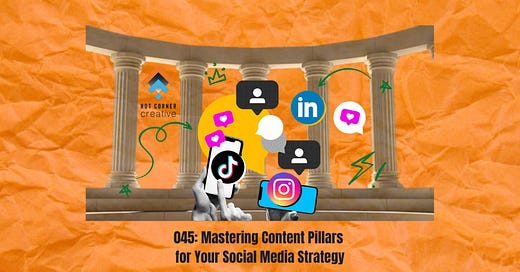045: Mastering Content Pillars for Your Social Media Strategy
Peace and Light and welcome back to the Hot Corner of the internet.
If you’re reading this, just know, the original post was all about what we do now that TikTok is no more. But that didn’t age well. So instead, I decided to pivot and take deeper or more strategic plunge into a topic that I highlighted in the last year. I just feel like this mindset and practice is needed more than ever from the looks of things. And I’m having brand and social strategy conversations that seem redundant that call for the need of content pillars. This is usually the missing link.
In the he landscape of brand building and growth — I want to help you find a nexus point in not fumbling your entire social media content strategy with this simple guide.
Social media is a powerful tool for businesses and individuals looking to expand their reach and engage with their audience effectively. However, the success of social media marketing hinges significantly on the strategic planning of content, which brings us to the concept of CONTENT PILLARS. These are not just arbitrary topics; they're carefully chosen themes that represent the core subjects your content will consistently cover to align with your business objectives.
The “spray and pray” social media posting method not only alienates, it disengages the audience; the general confusion can cause a brand to take giant leaps backwards.
Below, we will get into a fool-proof strategy of “content pillars” how you can develop and refine these pillars to enhance your social media strategy effectively.
Understanding Content Pillars
A content pillar is a consistent theme or topic that a brand consistently addresses in its social media content. These pillars form the foundation of your content strategy, ensuring that all content serves a strategic purpose. It's crucial to understand that content pillars:
Are not just themes like educational, inspirational, or entertaining (though these describe content tones).
Are not specific products or services.
Are not formats or types of content like reels or blog posts.
Instead, content pillars are value-based categories that directly contribute to your overall business and marketing goals. They should always be tied back to what you want to achieve through your social media presence, whether it’s brand awareness, lead generation, or customer education.
Setting Up Your Content Pillar Framework
This framework provides a structured approach to developing your content pillars. Below is a step-by-step breakdown.
Purpose
Begin by clearly defining your business goals and what you want your content to achieve. Are you aiming to increase product sales, drive traffic to your store, or establish yourself as a thought leader in your industry? Once these goals are established, consider the actions you want your audience to take after interacting with your content, such as visiting a landing page or following/engaging with your social media profiles, or watching your long-form content…etc.
Identify Your Audience
Knowing who you’re talking to is crucial. Your content needs to be tailored to the interests, needs, and challenges of your target audience. Create audience personas to better visualize whom you're creating content for, and use tools like social listening and audience insights to refine your understanding of your audience over time.
List Topic Ideas
Brainstorm a wide range of topics based on your expertise and your audience's needs. Tools like Google autocomplete, Answer the Public, and Pinterest can help you find what questions your audience is asking and what information they’re seeking. Also, analyzing competitors and larger players in your industry can provide inspiration and reveal gaps in their content that you might fill.
Link Back to Goals
Every topic you consider should directly tie back to your overarching business goals. Ask yourself how a given topic will help you grow your audience, build trust, or increase sales. This step ensures that your social media efforts contribute to tangible business outcomes.
Assign Your Pillars
From the broad topics you've listed, select three to five to develop into your main content pillars. These should be specific, aligned with your strategy, and sufficiently inspiring to you and your team. For instance, instead of a generic pillar like "education," use "DIY tips” to directly reflect the content you plan to offer.
Refine Your Pillars
Review each chosen pillar for specificity and uniqueness, ensuring they don't overlap and each has a clear set of associated calls to action. Aim to create at least ten content ideas under each pillar to ensure it's robust and sustainable.
Set Your Content Strategy
Finally, incorporate these pillars into a detailed content calendar. Assign each pillar to specific days, weeks, or months, and develop repeatable content formats for efficiency.
Example Content Calendar Layout:
Tracking the performance of each pillar through engagement metrics and sales data will help you understand what's working and what may need adjustment.
Monitoring and Adjusting Your Strategy
An effective social media strategy is never static. Continual monitoring and adjustment based on performance analytics are key. Evaluate which pillars and specific posts are performing best and consider adjusting your strategy to do more of what works and less of what doesn’t. In short, make active social listening a high priority at this point.
Final Thoughts
Content pillars are crucial for creating a focused, strategic approach to social media marketing. By following this framework, you can ensure that your social media content not only attracts attention but also contributes to your business goals in meaningful ways.
Content pillars streamline your social media management and ensure every piece of content serves a purpose. Start building your pillars today and transform your social media presence into an effective, goal-driven component of your business strategy.





